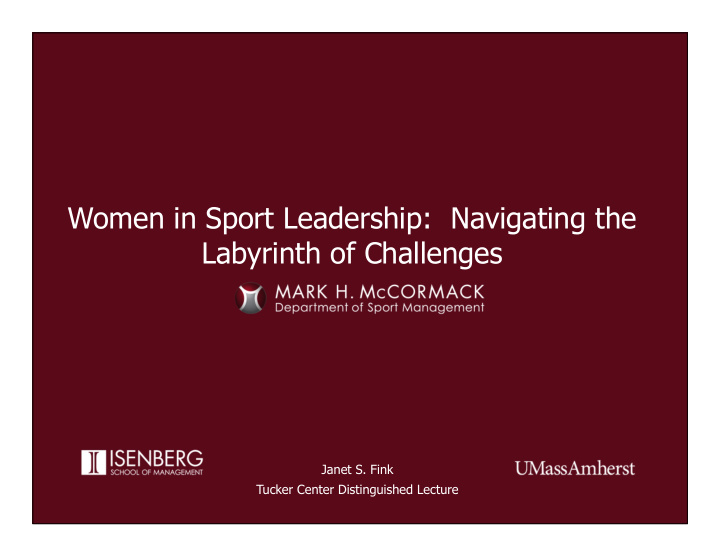



Women in Sport Leadership: Navigating the Labyrinth of Challenges Janet S. Fink Tucker Center Distinguished Lecture
Background Since 1981 women comprised 50% of college graduates • In 2010, 57% of college students were women • In 2011, women comprised 47% of overall workforce and • 59% of entry level, college educated workforce Only 12 women leading Fortune 500 companies in 2012 • Women still earn only 77 cents to every man’s dollar • (Spar, 2012) Navigating the Labyrinth of Challenges
Women and Sport Leadership -- NCAA ◦ Substantial decrease in female administrators as women’s sport programs were appropriated by/ Athletic Directors collapsed into existing men’s programs. 90% to 20% in 2012 100% ¡ Only 4.9% of AD’s in FBS schools are Men ¡ female 50% ¡ Women ¡ Average of only 1.4 female administrators per administration 0% ¡ 411 fewer females in administrative 1973 ¡ 2012 ¡ positions since 2008 57.1% of women’s teams coached by women 2% of men’s teams coached by women (Acosta & Carpenter, 2012) Navigating the Labyrinth of Challenges
Women in Sport Leadership – Professional Sport 70% ¡ 64% ¡ 63% ¡ 60% ¡ 52% ¡ 50% ¡ 42% ¡ 40% ¡ 33% ¡ WNBA ¡(A-‑) ¡ 30% ¡ 25% ¡ 20% ¡ 20% ¡ NBA ¡(B) ¡ 15% ¡ 10% ¡ MLB ¡(C+) ¡ 3% ¡ 3% ¡ 0% ¡ 0 ¡ 0 ¡ 0% ¡ 0% ¡ NFL ¡(C+) ¡ The ¡Ins@tute ¡for ¡Diversity ¡and ¡Equity ¡in ¡Sports ¡ (2012) ¡ Navigating the Labyrinth of Challenges
Glass Ceiling? Worst ¡of ¡all, ¡by ¡depic@ng ¡a ¡single, ¡unvarying ¡obstacle, ¡the ¡glass ¡ceiling ¡fails ¡to ¡ incorporate ¡the ¡complexity ¡and ¡variety ¡of ¡challenges ¡that ¡women ¡can ¡face ¡in ¡their ¡ leadership ¡journeys. ¡In ¡truth, ¡women ¡are ¡not ¡turned ¡away ¡only ¡as ¡they ¡reach ¡the ¡ penul@mate ¡stage ¡of ¡a ¡dis@nguished ¡career. ¡ ¡They ¡disappear ¡in ¡various ¡numbers ¡at ¡ many ¡points ¡leading ¡up ¡to ¡that ¡stage” ¡(Eagly ¡& ¡Carli, ¡2007, ¡p. ¡64). ¡ Navigating the Labyrinth of Challenges
Cunningham & Sagas (2008) Macro ¡ Meso ¡ Micro ¡ Navigating the Labyrinth of Challenges
Micro Level Forces • Focus on individual females and their attitudes, qualifications, characteristics, etc. • Attitudes/Beliefs Self Efficacy • Sandberg (2012) Men more likely to attribute success to themselves, women more likely to attribute • success to outside forces (e.g., luck, help from others). Furnham (2011) • “Men with average to below average intelligence tend to think they are quite clever – • and very smart women think their intelligence is low” (Adrian Furnham, quoted in Raymond, 2009, ¶ 4). Greenhill, Ault, Cuskelly, & Hooper (2009) • Elite level female coaches will not apply for job unless they have ALL qualifications • listed in the job posting. “For some reason, men, it doesn’t bother them that they never played or they don’t • know the game, they think they know , so they are the ones out there coaching” (Messner, 2009, p. 53).
Meso Level Forces • Focuses on organizational level and the factors that sustain gendered nature of sport • Simple • Female administrators often denied oversight of marquee men’s teams not “qualified” for AD role (Lough and Grappendorf, 2007) • More Complex • Those in control within their organizations tend to sustain their dominance by reproducing themselves based on physical or social characteristics (“Good Ole Boys Club”) Navigating the Labyrinth of Challenges
Homologous Reproduction – Alive and Well in 2012 Percentage ¡of ¡female ¡head ¡coaches ¡by ¡administra@ve ¡structure ¡ 60 49.1 50 45.9 40.7 44.3 41.9 40 39 36.7 Overall 33.7 No Female in ADMIN 30 Male AD 25 20 Female AD 10 0 DI DII DIII Navigating the Labyrinth of Challenges
Macro level Forces • Focus on forces outside of, or surrounding, the organization • Most pervasive and most difficult to combat Gender bias in the workplace • Valian (1999) Gender Schemas • Eagly et al (2000) Social Role Theory • Women = Communal Men = Agentic • Compassionate ¡ Decisive ¡ Gentle ¡ ¡ Ambi@ous ¡ So\ ¡Spoken ¡ Self ¡confident ¡ Kind ¡ Forceful ¡ ¡ Double Bind • Navigating the Labyrinth of Challenges
Double Bind For Female Leaders Burton ¡et ¡al ¡(2012) ¡ • Women ¡applying ¡for ¡the ¡AD ¡posi@on ¡were ¡rated ¡significantly ¡less ¡feminine ¡ than ¡a ¡female ¡applying ¡for ¡the ¡Life ¡Skills ¡Coordinator ¡posi@on. ¡ • Though ¡judged ¡to ¡have ¡similar ¡skills, ¡par@cipants ¡in ¡the ¡study ¡indicated ¡ the ¡male ¡applicants ¡were ¡significantly ¡more ¡likely ¡to ¡be ¡chosen ¡for ¡the ¡ Athle@c ¡Director’s ¡posi@on ¡than ¡the ¡female ¡candidate. ¡
Biggest Impediment Macro ¡ Uncontested ¡Sexism ¡ Meso ¡ Micro ¡ Navigating the Labyrinth of Challenges
Sexism in Sport “Go ¡back ¡to ¡the ¡ kitchen. ¡ ¡Go ¡back ¡ there ¡and ¡make ¡me ¡ some ¡bacon ¡and ¡eggs, ¡ would ¡you?” ¡ “I ¡didn’t ¡want ¡to ¡hire ¡her. ¡ ¡Lew ¡ (Perkins, ¡then ¡AD ¡at ¡Kansas) ¡ would ¡say ¡‘if ¡you ¡just ¡meet ¡her ¡ once, ¡you’re ¡going ¡to ¡love ¡her.’ ¡ ¡ But ¡I ¡kept ¡saying, ¡‘I ¡don’t ¡want ¡ to ¡hire ¡a ¡woman ¡to ¡be ¡a ¡men’s ¡ strength ¡coach, ¡who ¡does ¡that?” ¡ Boycoded: ¡ IBM ¡& ¡Other ¡Sponsors ¡ CBS ¡ Players ¡ Navigating the Labyrinth of Challenges
“Never ¡doubt ¡that ¡a ¡small ¡ group ¡of ¡thoughgul, ¡ Strategies for Change commided ¡ci@zens ¡can ¡ change ¡the ¡world. ¡ ¡Indeed, ¡it ¡ is ¡the ¡only ¡thing ¡that ¡ever ¡ • Take lessons from others has” ¡ ¡ ¡ (Margaret ¡Mead) ¡ • LGBT Research to practice • “It takes a team (WSF)” “Changing the Game ”(GLSEN) • Incredibly committed activists/advocacy groups • National Center for Lesbian Rights Sports Project • GLAD • Outsports.com • • Ramifications for women beyond sport context Must pressure leaders of sport organizations to acknowledge and • remedy these barriers Navigating the Labyrinth of Challenges
“The next frontier in the long history of achieving rights for women in the US is sports” (McDonagh & Pappano, 2008, p. 7)
Recommend
More recommend